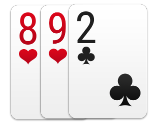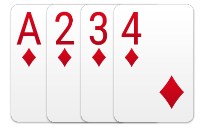
Joker In Rummy Game
In rummy, a joker is a special card that can be used as a wildcard to represent any other card in the deck or player’s hand. It is a precious card, as it can help players to form sequences or sets more easily.
The Joker card is one of the most crucial elements in the rummy card game. A joker can either be a “Printed Joker” or a “Wild Joker” (chosen at random from the deck before every round). The concept of the rummy joker is explained in detail below, along with the joker's rules and strategies.
Role of Joker in a Indian Rummy Game
If you are new to rummy and rummy joker rules seem daunting to you, read on to understand the various ways joker in rummy can be put to use.
The joker card plays an important role in Indian rummy. Joker is a versatile card, as it acts as a replacement for any missing card in an impure sequence or a set. For instance, if you have two consecutive cards from the same suit or two cards of the same rank but different suits, you can use a Joker rummy card instead of the missing card and form a sequence or set.
Moreover, the joker points in rummy are zero. Since points are negative in rummy, a very important role is played by the joker in the rummy game. Once you know the rules for using the Joker rummy online becomes easier to master.
History of Joker Card
The origins of the Joker card are somewhat mysterious. Still, it is believed to have emerged in the latter half of the 19th century.
Joker was introduced as the "best bower" in the game of Euchre during the 1860s. This role gave the Joker significant power in the game as it can outrank all other trump cards. Another theory suggests that the Joker's inspiration came from the Fool card in Tarot decks, incorporating its symbolic significance and unpredictable nature into the world of playing cards. The Joker's introduction might also be attributed to the creativity and experimentation of card game enthusiasts to disrupt the established rules of play.
Regardless of its origins, the Joker has become an iconic card in the world of playing cards. Its wild card status and ability to influence game outcomes have cemented its place in card games' popular culture.
Importance of Joker Card in Rummy
The Joker card plays a crucial role in the game of rummy, adding an element of unpredictability and strategic flexibility to the gameplay.
Wildcard Capability: The Joker's primary function as a wildcard allows it to represent any missing card in a sequence or set. This versatility makes it extremely valuable.
Strategic Flexibility: Players can use the Joker to break up opponents' combinations, extend their sequences or sets, or create new groups.
Unpredictability and Surprises: The Joker's wildcard nature introduces an element of unpredictability to the game. It also adds excitement and maintains suspense.
Adaptability to Different Rummy Variations: The Joker plays a strategic role in various rummy variations, including Indian rummy, gin rummy, and 13-card rummy.
Enhances Game Dynamics: The Joker's presence adds complexity to rummy gameplay. It encourages players to think strategically and anticipate their opponent's moves.
Balancing the Game: The Joker can help balance the game by providing players with opportunities to overcome unfavorable card distribution or circumstances.
Overall, the Joker card is an integral part of rummy. Its ability to adapt to different variations and its role in balancing the game make it an indispensable element in the world of rummy.
Types of Joker & Uses of Joker Card in Rummy
There are two types of jokers in the game of rummy: printed joker and wild joker.
Printed Joker
A card deck in rummy includes one printed joker card, which has an image of a joker or clown printed on it. For the joker rummy rules are simple. This card can be used as a replacement card in an impure sequence or in a set. The number of printed jokers in a game can be either one or two, based on the number of decks that are being used in the game.

Sequences containing a printed joker

Sets containing a printed joker
Use of Printed Joker in Rummy
As shown above, a printed joker can be used as a replacement card in an impure sequence or a set.
Wild Card Joker
When cards are dealt, a random card from the suit is selected as the wild joker in rummy. Additionally, all the other suit cards of that value also become wild card jokers in that game. For example, if 6♥ is the wild joker in a game, 6♠, 6♦ and 6♣ will also be wild jokers in that particular game of rummy.

Sequences containing a wild joker (WJ)
-17074710105518.webp?v=1707471011)
Sets containing a wild joker
Use of Wild Card Joker in Rummy
A wild card joker can also be used like a printed joker to form an impure sequence or a set. However, it can also be used to form a pure sequence if used in its original value and not as a substitute.

(Here the wild joker 2♣ helps create an impure sequence. )

(In the same game, the wild joker 2♦ has been used in its original value and as a card of its original suit to complete a pure sequence.)
How to Form Sequences and Sets With Joker Cards (Printed and Wild Card Jokers)
If you know . how to play a joker rummy game, then you must be aware that a rummy game can be won even with a weak hand. You must know how to create sequences and sets using jokers. Here’s a detailed explanation of the rules.
Pure Sequence with Joker Card
A pure sequence is formed when three or more sequential cards of the
same suit are grouped together. You cannot use jokers in a pure
sequence, unless they are wild jokers used in their original value and
not as a substitute.
For example, if you have 5♦, 6♦
and 7♦, considering 7♦
is a wild joker, the card group 5♦-6♦-7♦ (WJ) will be considered a pure sequence.
This is because the wild joker has been used as a card of its original
suit (belongs to the same suit as the other two cards) and in its
original value (7).
Impure Sequence with Joker Card
An impure sequence in rummy is a sequence in which one or more cards
have been replaced by a joker/jokers.
For example, you have two consecutive cards of the same suit, say 8♠
and 9♠, and you draw a printed joker or a wild joker (e.g. 5♣). Now
the joker can be used as a replacement for the missing card, i.e. 7♠
or 10♠, thereby creating an impure sequence.
Use of Printed and Wild Card Jokers in Sets
A set in Indian rummy is a group of three or four cards of the same value but different suits. Creating sets is not mandatory, so you can arrange all your cards in only sequences, or in sequences and sets.
Valid Set with Printed Joker
If you have two cards of the same rank, say 8♦ and 8♣, and you pick a printed joker on your next turn. You can now use the printed joker to form a set: 8♦-8♣-PJ. Here the printed joker acts as a substitute for 8 ♥ or 8♠
Valid Set With Wild Card Joker
If you have two cards of the same rank, say 5♠ and 5♥, and you pick a wild joker (9♦ is the wild joker for that game) on your next turn. The wild joker can be used to complete the set: 5♠-5♥-9♦ (WJ). Here, the wild joker has been used as a substitute for 5♦ or 5♣.
Joker Card Rules in Rummy
For the use of the joker rummy card game rules are simple and easy to follow. You just have to remember three things.
Closed Joker Rummy Rules
The closed joker, also known as the printed joker, is used as a replacement card to form an impure sequence or a set. There can be one or two closed joker cards, depending on the number of decks used in the game.
Open Joker Rummy Rules
The open joker card, also known as the wild joker card, can be used in a pure sequence but only as a card of its original suit and not as a replacement card. If it is used as a replacement card, the sequence will be considered an impure sequence.
Top Strategies to Use Joker Card in Rummy
Mastering the art of using the Joker card in rummy can significantly enhance your chances of winning. Here are some top strategies to effectively utilize this versatile card:
Prioritize Completing Pure Sequences: Prioritize completing pure sequences as they are necessary and carry zero points, reducing your score and bringing you closer to winning.
Utilize the Joker with High-Value Cards: Use the Joker to make combinations with high-value cards. This strategy helps you reduce the points in your hand.
Discard Adjacent Cards to the Joker: If you receive a Joker card that fits with a sequence, consider discarding the adjacent cards to that Joker.
Utilize Jokers in Early Stages: In the early stages of the game, don't hesitate to use Jokers to gain an advantage. This can give you a head start in the game.
Disrupt Opponents' Combinations: If you notice an opponent is close to forming a combination, disrupt their sequence or set using your Joker. This gives you an advantage.
Practice and Experimentation: The key to mastering the Joker card is practice and experimentation. Try different approaches to using jokers in various situations.
FAQs on Joker Rummy
How do you play a joker in a rummy game?
The joker can be used as a replacement for any missing card in an impure sequence or a set, making it a valuable and versatile card in the game. It carries zero points.
Can we use a printed joker and a wild joker together in a sequence?
Yes, you can use both together to create an impure sequence.
How many printed jokers does a card deck in rummy contain?
Each deck contains 1 printed joker in Indian rummy.
How many points is a joker worth?
A joker is worth zero points.
Can I use the Joker to replace any card in Rummy?
Yes, you can use Joker to create any impure sequence or a set.
What are some strategies for using the Joker in rummy?
Use it to form other sets or sequences. However, don't rely solely on the Joker; focus on reducing your points too.
What are some common mistakes to avoid when using the joker in rummy?
Don't waste the Joker to complete a pure sequence; it's better utilized elsewhere. Also, don't hold onto the Joker for too long waiting for the perfect card; it may not come.
How can I improve my skills at using the joker in rummy?
Practice is key; the more you play, the more you understand when and where to use the Joker. Also, adapt your strategy based on the Joker you get (wildcard or printed).
Do the 52 cards include Jokers?
Jokers are additional cards and are typically not included in the standard deck of 52 cards.
-17359043711803.png?v=1735904371)